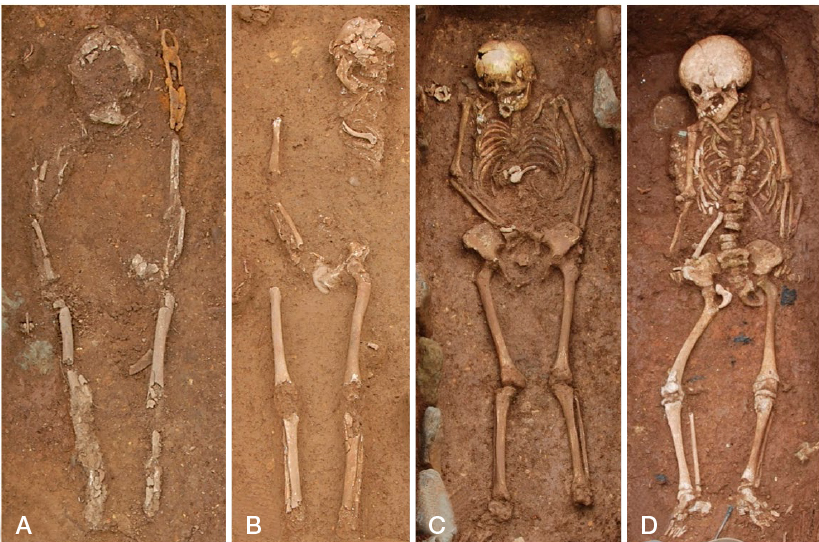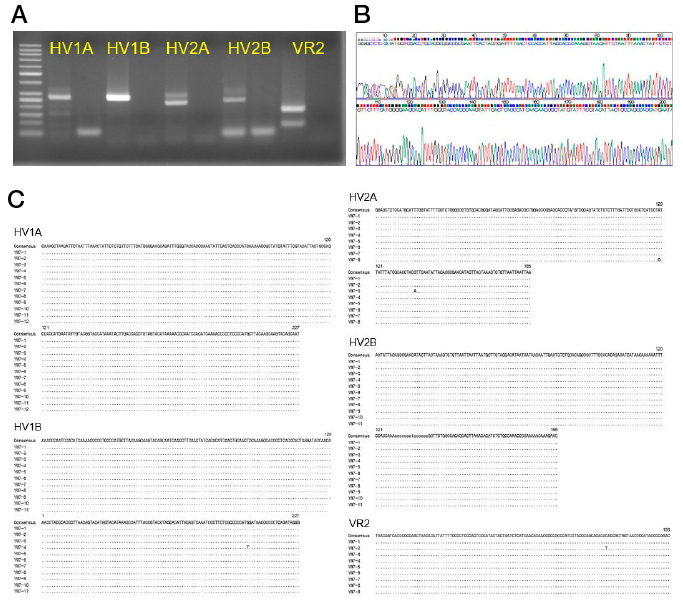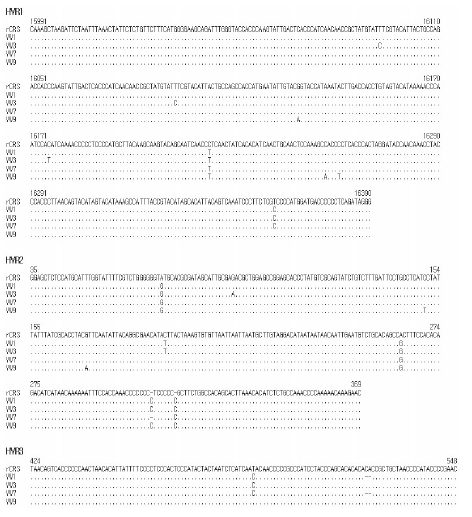Anat Biol Anthropol.
2019 Jun;32(2):61-67. 10.11637/aba.2019.32.2.61.
Mitochondrial DNA Analysis of the Human Skeletons from Goryeo Dynasty Graves Discovered at Youngwol, Gangwon-do
- Affiliations
-
- 1Department of Anatomy & Cell Biology, Seoul National University College of Medicine, Korea. oxman@snu.ac.kr
- 2Institute of Forensic Science, Seoul National University College of Medicine, Korea.
- KMID: 2451559
- DOI: http://doi.org/10.11637/aba.2019.32.2.61
Abstract
- In archaeological excavation sites in Korea, human skeletal remains of various periods were discovered. However, there have been very few studies on skeletal cases of Goryeo period so far. Therefore, in order to obtain the genetic profiles of Goryeo period Korean people at that time, we tried to reveal haplogroups by mtDNA analysis of four skeletons from Goryeo period graves. In this study, the haplogroup identified from them were D4b2b, D4e1a1, D4 and N9a1'3, respectively. This study is invaluable because it is one of the rare reports of genetic information of Korean people of Goryeo Dynsaty.
MeSH Terms
Figure
Cited by 1 articles
-
Revealing Joseon period People’s single nucleotide polymorphism associated with lactase gene by ancient DNA analysis of human remains from archaeological sites in Korea
Chang Seok Oh, Myeung Ju Kim, Yi-Suk Kim, Sori Min, Kyong Taek Oh, Soong Deok Lee, Dong Hoon Shin
Anat Cell Biol. 2023;56(1):54-60. doi: 10.5115/acb.22.178.
Reference
-
1. Oh CS, Shin DH, Hong JH, Lee SD, Lee E. Single-nucleotide polymorphism analyses on ABCC11, EDAR, FGFR2, and ABO genotypes of mummified people of the Joseon Dynasty, South Korea. Anthropol Sci. 2018; 126:67–73.
Article2. Oh CS, Koh BJ, Yoo DS, Park JB, Min SR, Kim YS, et al. Joseon funerary texts tested using ancient DNA analysis of a Korean mummy. Anat Rec. 2015; 298:1191–1207.
Article3. Oh CS, Lee SD, Kim YS, Shin DH. The use and effectiveness of triple multiplex system for coding region single nucleotide polymorphism in mitochondrial DNA typing of archaeologically obtained human skeletons from premodern Joseon tombs of Korea. Biomed Res Int. 2015; Aug. 06. [doi: 10.1155/2015/850648].
Article4. Lee WJ, Woo EJ, Oh CS, Yoo JA, Kim YS, Hong JH, et al. Bio-anthropological studies on human skeletons from the 6th century tomb of ancient Silla kingdom in South Korea. PLoS One. 2016; Jun. 01. [doi: 10.1371/journal.pone.0156632].
Article5. Shin DH, Oh CS, Hong JH, Kim Y, Lee SD, Lee E, et al. Paleogenetic study on the 17th century Korean mummy with atherosclerotic cardiovascular disease. PLoS One. 2017; Aug. 16. [doi: 10.1371/journal.pone.0183098].
Article6. Shin DH, Oh CS, Hong JH, Lee H, Lee SD, Lee E. Helicobacter pylori DNA obtained from the stomach specimens of two 17th century Korean mummies. Anthropol Anz. 2018; 75:75–87.
Article7. Jee SH, Kim YJ, Jung YJ, Seo MS, Park YJ. A paleogenetic analysis of human skeletal remains from the Myeongam-ri site, Asan in Korea. J Conserv Sci. 2008; 23:81–93.8. Kim YS, Oh CS, Lee SJ, Kim MJ, Choi SG, Min SR, et al. Construction of medieval skeleton collections with human remains from tombs of Goryeo dynasty, Korea. Korean J Phys Anthropol. 2010; 23:113–123.
Article9. Kim YJ, Kim SH, Jo EM, Lee JW. Mitochondrial DNA analysis of human skeletal remains excavated from Myungam-ri site in Asan, Korea. J Conserv Sci. 2015; 36:33–48.10. Dabney J, Meyer M, Pääbo S. Ancient DNA damage. Cold Spring Harb Perspect Biol. 2013; Jul. 01. [doi: 10.1101/cshperspect.a012567.].
Article11. Oh CS, Lee SJ, Park JB, Lee SD, Seo SB, Kim HY, et al. Autosomal short tandem repeat analysis of ancient DNA by coupled use of mini- and conventional STR kits. J Forensic Sci. 2012; 57:820–825.
Article12. Oh CS, Lee SD, Shin KJ, Shin DH. Effectiveness of coupled application of AmpFXMLLink_XYZSTR Yfiler Kit and reduced size Y-chromosomal short tandem repeat analysis for archeological human bones. J Forensic Sci. 2016; 61:430–438.13. Woo EJ, Jung HW, Oh JH. A study of human skeletal remains from a cremation burial of the Koryo period. Yaoegogohag. 2017; 29:71–96.14. Hofreiter M, Serre D, Poinar HN, Kuch M, Pääbo S. Ancient DNA. Nat Rev Genet. 2001; 2:353–359.
Article15. Willerslev E, Cooper A. Ancient DNA. Proc Biol Sci. 2005; 272:3–16.16. Holland MM. Molecular analysis of the human mitochondrial DNA control region for forensic identity testing. Curr Protoc Hum Genet. 2012; Jul. [doi: 10.1002/0471142905.hg1407s74.].
Article17. Kumar S, Stecher G, Tamura K. MEGA7: Molecular evolutionary genetics analysis version 7. 0 for bigger datasets. Mol Biol Evol. 2016; 33:1870–1874.18. Fan L, Yao YG. MitoTool: a web server for the analysis and retrieval of human mitochondrial DNA sequence variations. Mitochondrion. 2011; 11:351–356.
Article19. Aulicino ED. In: Genetic Genealogy: The Basics and Beyond. Arlington, Virginia: National Genealogical Society; 2013. pp. 32.20. Lee HY, Song I, Ha E, Cho SB, Yang WI, Shin KJ. mtDNAmanager: a Web-based tool for the management and quality analysis of mitochondrial DNA control-region sequences. BMC Bioinformatics. 2008; 11. 17. [doi: 10.1186/1471-2105-9-483].
Article21. Yu JA, Oh CS, Hong JH, Min SR, Oh SW, Kim YS, et al. Stable isotope analysis of Joseon people skeletons from the cemeteries of Old Seoul City, the capital of Joseon Dynasty. Anat Cell Biol. 2014; 47:244–252.
Article22. Kim NY, Lee HY, Park MJ, Yang WI, Shin KJ. A genetic investigation of Korean mummies from the Joseon Dynasty. Mol Biol Rep. 2011; 38:115–121.
Article23. Kim YS, Oh CS, Lee SJ, Park JB, Kim MJ, Shin DH. Sex determination of Joseon people skeletons based on anatomical, cultural and molecular clues. Ann Anat. 2011; 193:539–543.24. Hershkovitz I, Spigelman M, Lim DS, Lee IS, Oh CS, May H, et al. A possible case of Cherubism in a 17th-century Korean female mummy. PLoS One. 2014; May. 08. [doi: 10.1371/journal.pone.0102441].25. Kahila BG, Kim MJ, Klein A, Shin DH, Oh CS, Kim JW, et al. Tracing hepatitis B virus to the 16th century in a Korean mummy. Hepatology. 2012; 56:1671–1680.
Article26. Macaulay V, Hill C, Achilli A, Rengo C, Clarke D, Meehan W, et al. Single, rapid coastal settlement of Asia revealed by analysis of complete mitochondrial genomes. Science. 2005; 308:1034–1036.
Article27. Kivisild T, Tolk HV, Parik J, Wang Y, Papiha SS, Bandelt HJ, et al. The emerging limbs and twigs of the East Asian mtDNA tree. Mol Biol Evol. 2002; 19:1737–1751.
Article28. Torroni A, Achilli A, Macaulay V, Richards M, Bandelt HJ. Harvesting the fruit of the human mtDNA tree. Trends Genet. 2006; 22:339–345.
Article29. Salas A, Carracedo A, Macaulay V, Richards M, Bandelt HJ. A practical guide to mitochondrial DNA error prevention in clinical, forensic, and population genetics. Biochem Biophys Res Commun. 2005; 335:891–899.
Article30. Kivisild T, Tolk HV, Parik J, Wang Y, Papiha SS, Bandelt HJ, et al. The emerging limbs and twigs of the East Asian mtDNA tree. Mol Biol Evol. 2002; 19:1737–1751.
Article31. Metspalu M, Kivisild T, Metspalu E, Parik J, Hudjashov G, Kaldma K, et al. Most of the extant mtDNA boundaries in south and southwest Asia were likely shaped during the initial settlement of Eurasia by anatomically modern humans. BMC Genet. 2004; 5:26.32. Tanaka M, Cabrera VM, González AM, Larruga JM, Takeyasu T, Fuku N, et al. Mitochondrial genome variation in eastern Asia and the peopling of Japan. Genome Res. 2004; 14:1832–1850.
Article
- Full Text Links
- Actions
-
Cited
- CITED
-
- Close
- Share
- Similar articles
-
- Construction of Medieval Skeleton Collections with Human Remains from Tombs of Goryeo Dynasty, Korea
- History of the medical licensing examination (uieop) in Korea's Goryeo Dynasty (918-1392)
- Bioarchaeological Studies on Ancient Human Skeletons in Korea
- Anthropological Study on Human Skeletons from Joseon Tomb, for Confirming Ryu Ja-Gwang, a Famous Historical Figure of Medieval Korea
- Stable isotope analysis of Joseon people skeletons from the cemeteries of Old Seoul City, the capital of Joseon Dynasty




